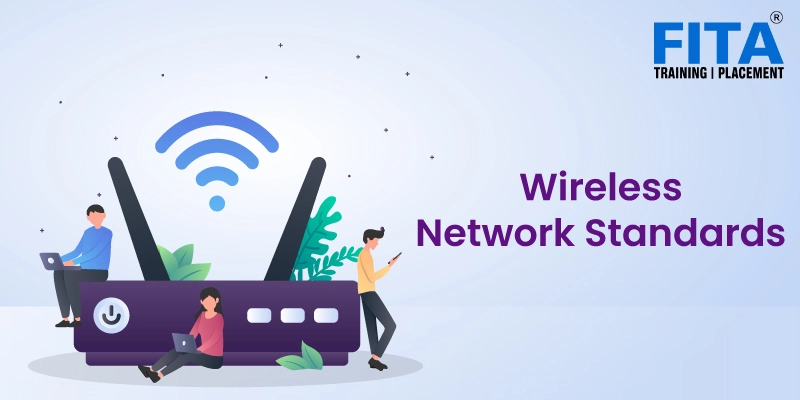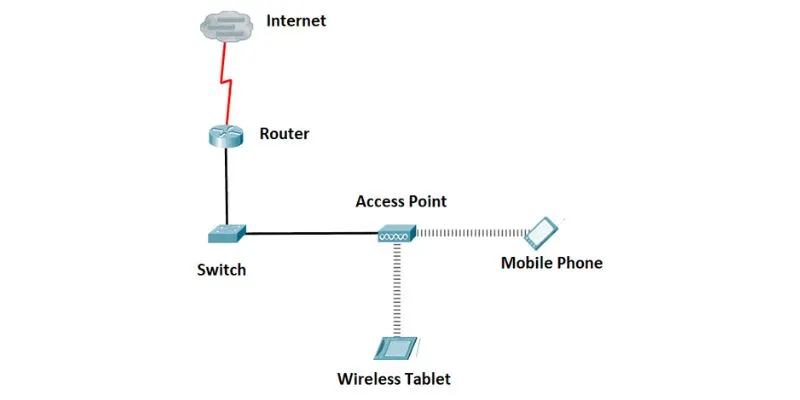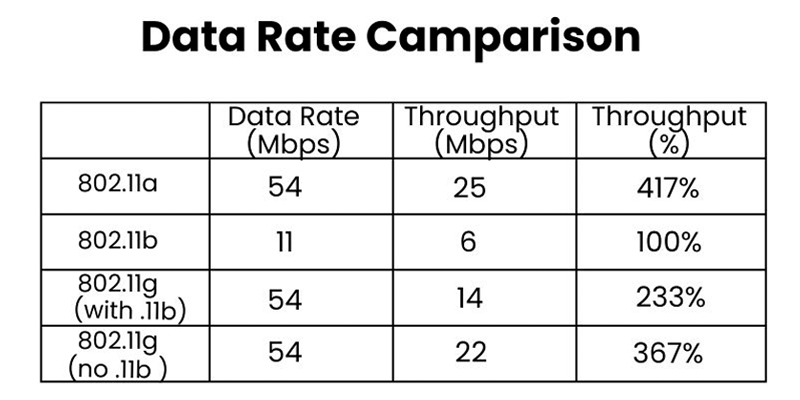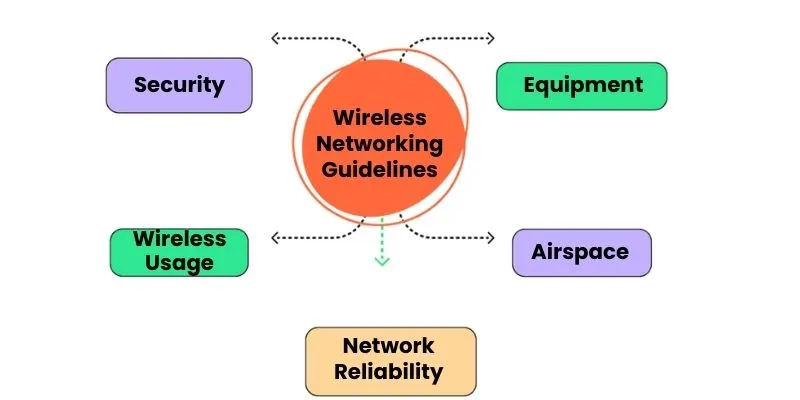
The available wireless networking equipment supports various levels of industry communication standards. Currently, the widely accepted standard in the industry is IEEE 802.11b/g, which effectively balances range, network throughput, and support for device mobility to meet the majority of the community’s needs. As emerging standards, such as IEEE 802.11 enhancements, come into play, they will undergo evaluation, and deployment will occur if they demonstrate advancements in security and throughput over the existing 802.11b/g standard.
The wireless network standards are committed to providing the most advanced technology while prioritizing stable and reliable service for the network standards. IT will consistently assess both wireless network industry standards and equipment to ensure that the network standards align with this objective. For individuals aspiring to deepen their understanding of technology standards and contribute to the security of wireless networks, enrolling in a reputable Cyber Security Course in Chennai can be a valuable step. This educational opportunity equips individuals with the knowledge and skills needed to navigate the complexities of network security and uphold the integrity of evolving technology standards.
What are the Wireless Network Standards?
Wireless Access Point
A hardware device for wireless communications that establishes a central point of connectivity is referred to as a wireless access point. Similar to a “hub,” this device shares the total bandwidth among all users with an active network connection that it is servicing.
Wireless Port
A network port specifically designed for connecting a wireless access point to the network standards’s wired network is termed a wireless port. These ports deliver both data and power services to the wireless access point and are easily distinguishable from standard network ports by a prominently affixed yellow warning label. Due to the dual function of transmitting both data and electrical power, connecting regular end-user devices to this type of port could result in significant damage.
Wireless client software or built in 802.1x supplicant
IT offers client software designed to enable computers to employ 802.1x authentication for both wired and wireless networks. Certain operating systems come equipped with built-in support for 802.1x and can be employed to access the network. The client software provided by the network standards comes preconfigured to facilitate the specific setup requirements for Net Wi-Fi.
Coverage Area
The geographical region within which satisfactory wireless service quality can be achieved is referred to as the coverage area. Disparities in coverage areas for similar devices can arise due to factors such as building materials, interference, obstructions, and the strategic placement of access points.
Interference
The decline in the quality of a wireless communication radio signal due to the influence of electromagnetic radiation from external sources is known as interference. These sources encompass various devices like other wireless access points, cellular telephones, microwave ovens, medical and research equipment, and other devices that emit radio signals. The impact of interference can range from a partial degradation of a wireless transmission to the complete elimination of the signal, contingent upon the strength of the signal emitted by the interfering device.
Privacy
The state attained through the successful preservation of confidentiality for personal, student, employee, and/or patient information transmitted over a wireless network is commonly referred to as secure communication.
Security
Security holds particular significance in wireless networks due to the transmission of data using radio signals, which, without the implementation of specific data encryption mechanisms, can be susceptible to interception.
Wireless Network Infrastructure
The comprehensive assembly of wireless access points, antennas, network cabling, power infrastructure, ports, hardware, and associated software involved in the implementation of a wireless communication network is collectively referred to as the network infrastructure.
Wired Equivalent Privacy (WEP)

WEP (Wired Equivalent Privacy) is a security protocol established for wireless networks under the 802.11b standard. Its purpose is to deliver a security level equivalent to that of a wired network. However, recent reports highlight that relying solely on WEP may not be adequate to guarantee privacy unless it is complemented by additional mechanisms for data encryption.
WPA
Wi-Fi Protected Access (WPA) is an abbreviated term for a Wi-Fi standard developed to enhance the security aspects compared to WEP. This technology incorporates improved data encryption using the temporal key integrity protocol (TKIP) and user authentication through the extensible authentication protocol (EAP), specifically PEAP – MSChapV2. The WPA protocol is employed in Net Wi-Fi for enhanced security. For those interested in delving deeper into the realm of cybersecurity and gaining expertise in safeguarding wireless networks, considering enrolling in a reputable Cyber Security Course in Bangalore at FITA Academy can provide valuable insights and skills. This educational opportunity equips individuals with the knowledge needed to understand and implement robust security measures in the dynamic landscape of wireless technology.
802.1x
This standard augments the security of local area networks by offering an authentication framework that enables users to authenticate with a central authority, such as LDAP or Active Directory. When utilized in conjunction with 802.11 access technologies, it serves as an effective mechanism for regulating access to the wireless local area network.

802.11a
An extension to the 802.11 standard, developed by the IEEE for wireless network technology, is denoted as 802.11a. This standard is applicable to wireless local area networks, providing a maximum connect rate of 54 Mbps throughput in the 5GHz band. It is important to note that 802.11a is not backwards compatible with 802.11b/g and necessitates the use of special wireless adapters.
802.11b
An extension to the 802.11 standard, formulated by the IEEE for wireless network technology, is referred to as 802.11b. This standard is designed for wireless local area networks, offering a maximum connect rate of 11 Mbps with fallback options to 5.5, 2, and 1 Mbps. Operating in the 2.4GHz ISM band, 802.11b was officially ratified in 1999.
802.11g
An extension to the 802.11 standard enabling a maximum connect rate of 54 Mbps while ensuring compatibility with the 802.11b standard in the 2.4GHz band is known as 802.11g. This specification is both compatible and complementary to the 802.11b standard.
802.11i
An extension to the 802.11 standard developed to enhance security beyond the capabilities of 802.11 extensions is denoted as 802.11i. This extension introduces improved encryption methods and integrates the IEEE 802.1x authentication protocol, along with advanced encryption mechanisms like AES (Advanced Encryption Standard), offering an optional yet fully compliant implementation of 802.11i.
802.11n
Utilizing multiple transmitter and receiver antennas, also known as multiple-input and multiple-output (MIMO), to enable heightened data throughput and extended range characterizes the wireless standard ratified in 2009. It is essential to note that commercially available pre-standard hardware is incompatible with Net Wi-Fi.
Infrastructure Mode
The operational mode for wireless networks in which each end-user device is set up to associate with a wireless network access point through which network services are accessed is commonly referred to as “Infrastructure Mode.”
Ad Hoc Mode
The operational mode for wireless service in which end-user devices engage in a “peer-to-peer” configuration, interacting directly with each other, is known as “Ad hoc mode.” This mode does not necessitate the use of a wireless network access point.
If you want to know more about the latest salary trends for network engineers, Check out Network Engineer Salary for Freshers, which will help you get an insight into the packages as per the companies, skills and experience.
Utilization
Before deploying any wireless devices, IT will assess the usage requirements of the designated area to determine the optimal number of wireless access points necessary for efficiently supporting all users concurrently. Factors such as space configuration, construction materials, the anticipated number of end-user devices, and potential sources of radio frequency interference will be considered during the site survey.
IT will exclusively offer support for infrastructure mode installations, which require a minimum of one wireless access point. Ad hoc wireless mode installations will not be supported.
To prevent issues arising from radio interference, safeguard the integrity of resources, and ensure the broad availability of reliable wireless networking services, the network standards will retain sole ownership of all unlicensed spectrums of radio frequencies applicable to any of its campuses and associated properties.
Network Bandwidth
Under the 802.11b/g standard, the maximum network bandwidth accessible through a single wireless access point is 54 Mbps, shared among all users connected to that access point. In comparison, a standard wired network port provides switched 100 Mbps of dedicated bandwidth per user.
In a wired network, individual user throughput is higher due to the absence of direct bandwidth competition, with dedicated 100 Mbps allotted for each user on switched ports. However, in wireless networks, users share available bandwidth, potentially leading to diminished network performance as more wireless users connect to the access point. Bandwidth-intensive applications can further reduce the shared bandwidth for all users in the coverage area. Actual throughput in wireless coverage areas varies based on the number of users and the types of applications used on client computers.
Wireless clients using 802.11b-only adapters significantly diminish available bandwidth due to the backward compatibility design of the 802.11b/g standard. Consequently, IT recommends that client adapters support 802.11b/g as the preferred access method. While wireless network installations are suitable for low-bandwidth activities like web browsing and email, high-bandwidth activities such as streaming video, MP3 sharing, and videoconferencing may result in reduced performance. network standards units are advised to discourage these high-bandwidth activities until industry standards and equipment are available to adequately support them. Despite vendor claims, current wireless network technology effectively accommodates 15-25 users utilizing a single wireless access point. Further details can be found in the Bandwidth Usage Guideline section.
Wireless Networking Guidelines

Equipment
The integration of wireless network access points or other wireless communications equipment into the network will be exclusively conducted by IT.
The connection of wireless network access points to the network standards wired network will be facilitated through specially designated wireless ports installed for this purpose. network standards units and individuals are prohibited from disconnecting a wireless access point from its associated wireless port or interfering with any components of the wireless access point assembly, including antennas, antenna cables, or management cables. Wireless ports are configured to supply electrical power to the wireless access point and may cause permanent damage to improperly connected end-user devices.
Wireless network installations at network standards locations will include the necessary Wi-Fi certified wireless access point devices. The determination of the required number of access points will be based on initial estimates of user demand and the size of the area to be covered. If the number of users exceeds the practical capacity of a single access point to provide sufficient bandwidth, additional access points may be installed. In high-density user areas, such as classrooms and lecture halls, extra access points will be added to meet usage requirements. IT will be responsible for the installation and maintenance of all wireless access point devices. Enrolling in a reputable Ethical Hacking Course in Chennai can provide valuable insights and skills for individuals interested in understanding the intricacies of network infrastructure and exploring ways to enhance its security. This educational opportunity equips individuals with the knowledge to assess and fortify network security, including the deployment of wireless access points.
Network Reliability
To ensure the reliable performance of the network, IT will examine reports of specific wireless devices suspected of causing interference and performance issues, similar to the investigation process for wired ports. While IT will not actively monitor the content on the University’s wireless network radio frequencies during investigations, wireless network detection equipment will be employed to identify unauthorized wireless network equipment. Units are mandated to remove any such equipment discovered in unit-controlled University space.
Wireless access service is delivered based on anticipated utilization data obtained during initial site surveys conducted by IT. However, an increase in the number of users may lead to diminished wireless network performance.
Current industry standards for wireless network service do not provide sufficient throughput for effective support of bandwidth-intensive applications and network services. IT prohibits the use of serving-based applications (file, web, media servers) on Net Wi-Fi.
IT will prioritize addressing problems encountered in the use of wireless network services according to the following order: public access, academic, research, administrative, and staff use.
Security
Access to the University’s wireless networks will necessitate all authorized users in all areas to authenticate to the network using their assigned University Computing Account username and password, utilizing University-provided wireless client software or an 802.1x supplicant. Network access logs will be retained, containing user information, access time, and duration, and may be disclosed to authorized governmental authorities if required.
The wireless technology Implemented also includes the implementation of WPA (Wi-Fi Protected Access), which enhances data encryption through the temporal key integrity protocol (TKIP) and employs the extensible authentication protocol (EAP) for user authentication. To bolster security, all University wireless networks will mandate end user authentication using an 802.1x supplicant or provided wireless client software upon connecting any wireless end-user device. Authentication to the network will require the user’s University Computing Account and password, utilizing the University’s Central Directory Service as the authentication basis for services, including wireless network access.
The utilization of WPA and 802.1x for user authentication ensures advanced security levels for University wireless network users. IT will phase out older, less secure security methods in the future as advanced encryption mechanisms like Temporal Key Integrity Protocol (TKIP) and Advanced Encryption Standard (AES) are now practically deployable. Reports have highlighted weaknesses in the WEP protocol, suggesting it should not be used for safeguarding sensitive data. With the adoption of newer encryption mechanisms and user authentication protocols, these weaknesses are mitigated. While the wireless network’s security is now comparable to the wired network, access to sensitive information stored on protected central services via Net Wi-Fi will be restricted, and units using the wireless network in their daily operations will not be granted exceptions through the IT firewalls without the use of a VPN (VPN or IPSec).
University students, faculty, staff, and units must adhere to the terms outlined in all relevant University acceptable use policies, network usage guidelines, and applicable local, state, and federal regulations when using equipment connected to the University’s network, regardless of whether the connection is wireless or wired. Violations of these guidelines will be reported to the University’s computer incident response team and may be forwarded to the appropriate University or governmental authorities.
Users should be mindful that the use of wireless network connections may heighten the risk of unauthorized interception of confidential information. This risk is inherent in wireless network technology, despite the security measures implemented by the University. Consequently, users are encouraged to avoid sending or receiving confidential or sensitive data via wireless connections whenever possible. For individuals interested in understanding and addressing the security challenges posed by wireless networks, enrolling in a reputable Ethical Hacking Course in Pondicherry can provide valuable insights and skills. This educational opportunity equips individuals with the knowledge to assess and fortify network security, including mitigating risks associated with wireless communication.
Wireless Usage
Certain services can adversely impact a wireless network by generating high levels of network activity. Such services can have a detrimental effect on both the performance of your wireless network and that of other users sharing the network. Since the wireless network operates as a shared resource, the available bandwidth for each user connected to an access point may decrease as high-bandwidth services are utilized. If a student, faculty member, or staff member requires a service with high bandwidth demands, it is recommended to use a wired network connection.
The following examples illustrate activities that consume high bandwidth. Please note that this list is not exhaustive.
- Using the connected computer as any type of server, such as:
- Web servers
- Peer-to-peer file sharing servers
- FTP servers
- Multiplayer game servers
Moreover, an unsecured computer may encounter issues leading to high bandwidth usage. Potential problems include:
- Infections by worms or viruses.
- Compromised systems running ftp, IRC, or other services, or malicious spyware programs.
Certain user activities may also excessively use wireless bandwidth. Examples of such activities include:
- Reinstalling an operating system
- Downloading and installing applications
- Performing system backups
- Transferring large files (images, video, music, databases) to other systems
Airspace
Potential issues may arise if other devices operate within the same radio frequency range (2.4 GHz) as the wireless network. Due to the potential for conflicts, it is crucial for all users to be aware of which technologies are allowed in our environment and which are not permitted.
To ensure the highest quality of wireless network service, all non-client devices utilizing the 2.4 GHz range should be taken out of service in any University building. Only devices that are part of the Net Wi-Fi network will be authorized to utilize the 2.4 GHz range.
This directive encompasses any device functioning as a wireless base station or router, such as the Apple Airport Base Station, or any other wireless router. Additionally, cordless phones, cameras, and audio speakers using the frequency band of 2.4 GHz or 5 GHz should not be used in areas with wireless coverage. For individuals seeking a comprehensive understanding of networking devices and their configurations, considering enrolling in a reputable CCNA Course in Chennai can provide valuable insights and skills in managing and optimizing wireless networks effectively.
IT Responsibilities
The responsibilities of IT regarding the wireless network service include:
- Development and maintenance of the wireless standard and wireless guidelines.
- Installation and maintenance of all equipment supporting wireless network service.
- Investigation and resolution of wireless communication interference problems.
- Deployment, management, and configuration of wireless network access in public areas, classrooms, and office spaces.
- Development and implementation of wireless network security protocols and practices.
- Provision of user training on wireless network security issues and acceptable use of wireless network services.
- Performance and security monitoring for all installed wireless access points, with the provision of performance statistics to University units upon request.
- Monitoring the development of wireless network technologies and evaluating their potential use within the University’s wireless infrastructure.
- Responding to problems reported to the 24/7 IT Help Desk in accordance with standard procedures and service levels.
If you want to know more about the latest interview questions for Networking, Check out Networking Interview Questions and Answers, which will help you get an insight into the job interview question, skills and experience.
Wireless User Responsibilities
- Adhere to the wireless network standard and related guidelines and policies established by the University.
- Implement recommended security software, hardware settings, patches, and protocols on end-user equipment used to access the wireless networks.
- Follow all relevant policies and procedures, of federal, state, and local laws, pertaining to the security of sensitive and confidential data when working with such data on the University’s wireless networks.
- Install wireless network interface adapters according to published instructions.
- Assume responsibility for the support and network troubleshooting of problems when using wireless network interface adapters not supported by IT.
- Immediately report known misuse or abuse of the wireless network or associated equipment to the 24/7 IT Help Desk.
In conclusion, understanding wireless network standards is essential for optimizing network performance and compatibility. The various standards such as 802.11n, 802.11ac, and 802.11ax offer different speeds, frequencies, and features to meet the diverse needs of users. By staying informed about these standards, individuals and businesses can make well-informed decisions when selecting and deploying wireless network equipment. This knowledge equips them to leverage the best available technology for their specific requirements, ensuring efficient and reliable wireless connectivity.

